Similarities and differences between wheat and rye in appearance, composition and application
Dark rye and white wheat bread are products that are easily distinguished on store shelves. But raw crops - rye and wheat - before processing, can only be distinguished from each other by a professional. We will tell you in more detail how these cereals differ and what are the features of their use.
The content of the article
Description of rye and wheat
Rye and Wheat - Plants of the Poaceae family, used in agriculture as forage crops.
Botanical Description and Uses of Rye
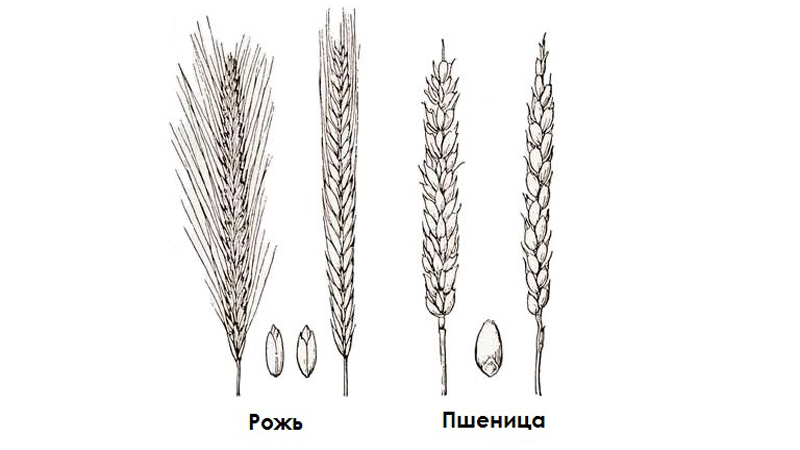
Rye (Secale) is a genus of herbaceous cereal plants, including about ten species. Rye (Secale cereale) is widespread in Russia as a fodder crop. The word rye also refers to the fruit of this plant.
Signs of rye seed:
- the root system is fibrous, extending to 1-2 m in depth;
- stem not branched, hollow, erect, with 5-7 internodes, pubescent under the ears, 80-100 cm long;
- leaf plates are broadly linear, gray in color, 15-30 cm long and 1.5-2.5 cm wide;
- inflorescence - compound spike, solitary, perched on the top of the stem, 5-15 cm long and 0.7-1.2 cm wide, spinous spike, awn 2-5 cm long;
- the flower has three stamens with anthers protruding from the spikelet;
- pollination - wind;
- the fruit is a caryopsis, compressed from the sides, has a deep groove, length - 5-10 mm, width - 1.5-3 mm, thickness - 1.5-3 mm, elongated or oval shape with transverse wrinkles on the surface, fruit color - from white to dark cinnamon.
The plant originates from wild relatives from the shores of Turkey (Anatolia region).
Unlike wheat, rye is more drought tolerant and not demanding on soil pH, which makes it a more hardy crop.
This culture is used in the food industry to make flour, kvass and rye bread. Rye is also used for the production of starch and alcohol.
In animal husbandry, fresh rye stalks are used as forage.
In agriculture, rye and mustard are the best siderates. They suppress the growth of weeds, loosen loamy soils, and displace nematodes.
Grains, rye bran and rye stalks are included in the diet. For patients with diabetes mellitus, endocrinologists recommend replacing white wheat bread with dark rye bread, as it has less glycemic index: 55 - for rye bread, 95 - for wheat bread made from premium flour.
Botanical Description and Uses of Wheat
Wheat is a genus of herbaceous annuals, including about 20 species. On the territory of Russia, hybrids and varieties of species are grown durum wheat (Triticum durum), English wheat (Triticum turgidum), soft wheat (Triticum aestivum) and spelled wheat (Triticum spelta).
Signs of the genus wheat:
- fibrous root system;
- stems are straight, glabrous, not branched, 30-150 cm tall;
- leaf blade linear or broadly linear, 3-15 mm wide, glabrous or hairy, rough;
- inflorescence - a complex ear, 3-15 cm long, with awns up to 18 cm;
- flowers with 3 stamens, anthers 2-4.5 mm long;
- pollination - wind;
- the fruit is a free oval or oblong caryopsis 5-10 mm long, covered with hairs at the top, has a deep groove.
Wheat is native to the southeast of Turkey. According to the assumption of the Russian scientist N.I. Vavilov, wheat comes from wild ancestors growing in Armenia.
In the food industry, wheat is a raw material for the production of flour, cereals, alcohol, vegetable wheat oil, bread, pasta and confectionery products.The distillery industry uses wheat to make vodka, beer, and whiskey. Protein is obtained from wheat grains - gluten (gluten), which is used as a thickener and stabilizer of the consistency of sausages, soft cheese, pates and desserts.
Attention! Gluten and foods containing gluten are contraindicated in patients with celiac disease (inability to break down gluten).
Wheat is a fodder crop in animal husbandry. The animals eat grains, haylage, straw, fresh herbs.
Unlike rye, wheat grain components are used in traditional medicine. Wheat starch is used as a filler for tablets, ointments, dusting powders, as well as for starching bandages. Wheat germ extract is an immunomodulatory drug used to stimulate immunity after injuries, illnesses and during the cold season. In cosmetology, this drug is used externally as a rejuvenating agent.
Wheat spikelets are used in floristry to give floral arrangements an ethnic mood.
Differences between rye and wheat
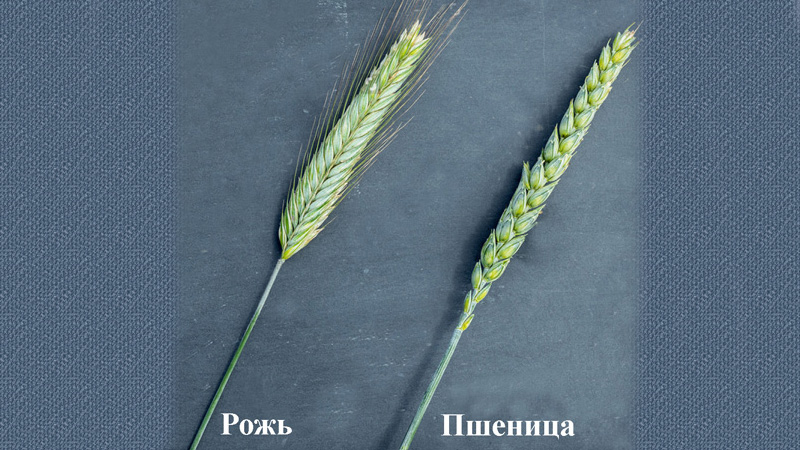
Rye and wheat grains are obtained from plants of different genera... These plants are rather distant relatives, but despite this, at the end of the 19th century, their hybrid, Triticosecale, was obtained, which is characterized by increased frost resistance. Let's take a closer look at how wheat and rye differ.
Comparative analysis of the composition of rye and wheat grains
Nutritional parameters of dry wheat and rye grains are shown in the table.
| Nutritional indicator | Value per 100 g of rye grains | Value per 100 g of wheat grains |
| Water | 14 g | 14 g |
| Carbohydrates | 55.8 g | 57.5 g |
| Alimentary fiber | 16.4 g | 11,3 g |
| Fats | 2.2 g | 2.5 g |
| Protein | 9.9 g | 13 g |
| Calorie content | 283 kcal | 304 kcal |
| Vitamin A | 2 μg | 1 μg |
| Beta carotene | 20 mcg | 10 mcg |
| Vitamin E | 2.8 mg | 3.4 mg |
| Vitamin B1 | 0.44 mg | 0.37 mg |
| Vitamin B2 | 0.2 mg | 0.1 mg |
| Vitamin B5 | 1 mg | 1.2 mg |
| Vitamin B9 | 55 mcg | 46 μg |
| Vitamin B6 | 0.41 mg | 0.6 mg |
| Vitamin H | 6 μg | 11.6 mcg |
| Vitamin PP | 4.8 mg | 12.2 mg |
| Choline | — | 94 mg |
| Potassium | 424 mg | 325 mg |
| Calcium | 59 mg | 62 mg |
| Silicon | 85 mg | 48 mg |
| Magnesium | 120 mg | 114 mg |
| Sodium | 4 mg | 8 mg |
| Sulfur | 85 mg | 100 mg |
| Phosphorus | 366 mg | 368 mg |
| Chlorine | 46 mg | 30 mg |
| Boron | 310 mcg | — |
| Iron | 5.4 mg | 5.3 mg |
| Iodine | 9.3 μg | 11 μg |
| Cobalt | 7.6 mcg | 5.4 μg |
| Manganese | 2.77 mg | 3.7 mg |
| Copper | 0.46 mg | 0.53 mg |
| Molybdenum | 18 mcg | 42 μg |
| Selenium | 25.8 mcg | — |
| Fluorine | 67 mcg | 80 mcg |
| Chromium | 7.2 μg | 5.5 mcg |
| Zinc | 2.04 mg | 2.81 mg |
Wheat is a higher calorie product than rye... Rye contains more B vitamins and vitamin A, but less vitamins H and PP. It also lacks choline.
Rye contains comparatively more potassium, silicon, chlorine, cobalt, chromium, selenium and boron. Wheat wins in terms of calcium, sodium, sulfur, iodine, manganese, molybdenum, fluorine and zinc content.
Differences in the properties of wheat and rye
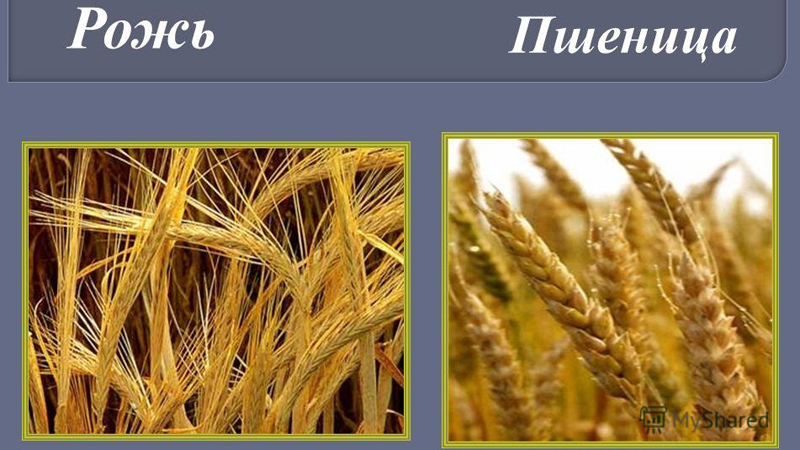
Besides traditional medicine, wheat and its seedlings used in folk recipes for the treatment of diseases. Rye is used in folk medicine and dietary nutrition. Let us consider in more detail what properties these cereals.
| Effect on the body | Rye | Wheat |
| Rejuvenation of the body | — | + (for seedlings) |
| Boosting immunity | + (for infusion of grains with honey) | + (for wheat germ extract) |
| Weight loss | + | — |
| Reinforcing effect on the intestines | + | + |
| Softening and nourishing the skin | — | + (for external use of decoctions as lotions) |
| Prevention of cardiovascular diseases | + (for decoction of whole grains) | — |
| Expectorant effect on cough | + (for decoction of whole grains) | — |
| Removal of joint pain | + (for decoction of whole grains) | — |
Bakery rye products have a lower glycemic index than similar products made from wheat flour, so they are used by patients with diabetes instead of wheat products.
Reference. Rye grains and products based on them contain gluten, like all fruits of the Cereals (Bluegrass) family, therefore they are contraindicated in patients with gluten intolerance.
Both rye and wheat products are contraindicated in patients with inflammatory bowel disease.
Differences in the appearance of rye and wheat
Not only the appearance of the plants, but also the appearance of the grains of these plants is different. Even bread baked from the flour of these cereals is different in appearance and taste: wheat bread is white, with a golden crust, sweetish in taste, and rye bread is dark brown with a black crust, has a characteristic sourness.
You can see how rye and wheat look in more detail in the photo.
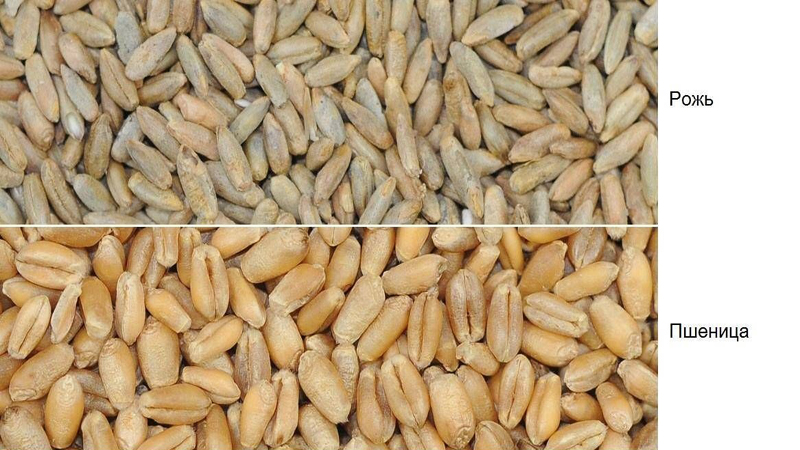
The table shows the comparative external characteristics of rye and wheat.
| External sign | Rye | Wheat |
| Spikelet appearance | The spike is thin with long awns | The spike is thick with breaking off thin awns |
| Stem height | Up to 2 m | Up to 1.5 m |
| Grain color | Light green, gray, dark brown | Light yellow, golden |
| Grain shape | Oblong | Oval |
| Pubescence of grains | Not | Grains pubescent at the top |
Differences between plants become noticeable during the period of spikelet ripening. Wheat loses awns and becomes amber, rye remains awn, gray-green in color.
Common signs of rye and wheat
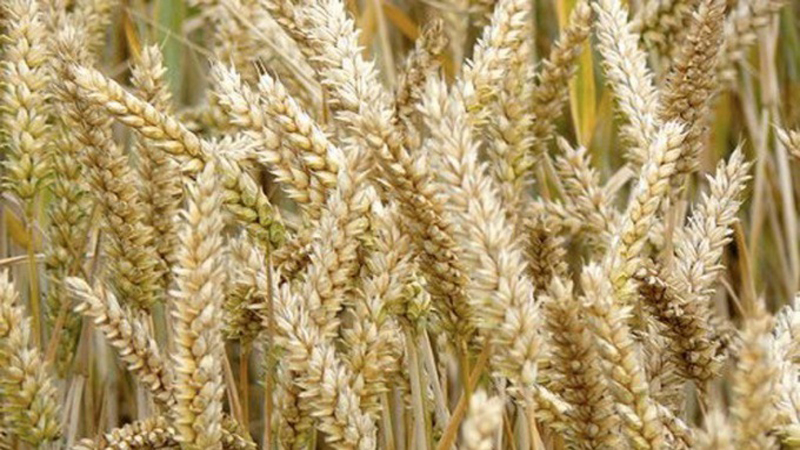
Since these forage crops are botanically close, they share a number of similar traits, which is why they are often confused.
Similarities between rye and wheat:
- common family - Cereals;
- origin - Turkey;
- the same type of root system;
- knotty structure of a hollow stem;
- linear leaves with longitudinal venation;
- the caryopsis of both plants has a characteristic longitudinal groove.
Both plants have a beneficial effect on the health of the body, they are used in folk medicine and dietary nutrition.
Conclusion
To distinguish between two cereals - rye and wheat - pay attention to the appearance of spikelets and grains. Mature spikelets of rye are thin and have long awns, grayish-green. Wheat spikelets are golden, awnless, thick. Rye grains are oblong, gray-green, but there are varieties with light and dark brown grains. Wheat grains are golden, pubescent on top, oval, have a characteristic longitudinal groove.
Wheat is used in the food industry, cooking, traditional and folk medicine. Rye products are used in folk medicine, food industry and cooking.